A Propane Refrigerator uses Liquefied Petroleum Gas (LPG) from a stored container called a tank or a cylinder which is regulated with a pressure regulator mounted at the tank and then plumbed to the point of use. These three components (tank, regulator, & plumbing) are all that is needed to get a propane gas refrigerator up and running. There are a few options on how to connect a propane refrigerator based on where the refrigerator is located. Below are some of the most common options and some tips and tricks.
Tank / Cylinder
A propane gas fridge will operate from any size tank or cylinder. The size or capacity only dictates the amount of time the gas fridge will operate before the tank needs to be re-filled.
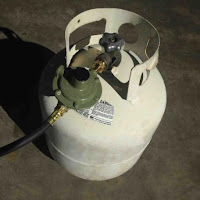 |
Small portable tank &
regulator
|
A tank may be as small as 5 gallons which is typical for a barbecue and is considered a portable tank. Portable tanks range in size up to about 25 gallons and when full, it will weigh about 100 Lbs. These small tanks are great for remote locations where the propane must be “hauled in”. Weighing only about 20 Lbs. when completely filled, the 5 gallon size are easily placed in the back of a pick-up truck or even on the back of a mule for transport. All of these portable tanks can be plumbed with a short flexible hose that is connected to the rigid pipe of the home. The regulator is typically mounted at the valve of the tank. There is an option to connect two tanks at one time via an automatic change over regulator. More on this in the “Regulator” section. These portable tanks should never be used indoors since the pressure upstream of the regulator is high pressure and a leak or venting of the tank can cause a high volume of gas to escape rapidly and be very dangerous around an open flame or any ignition source. Any tank larger than 100 Lbs. is not practical to transport on a regular basis. A larger permanent tank for an average home will generally range from 125 gallons up to 1000 gallons.
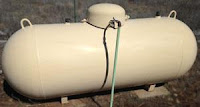 |
250 Gallon permanent tank
|
The larger non-portable permanent tanks are typically set outside of the home. Local code requirements will specify minimum distances from structures and property lines. Access to the tank is required for the delivery vehicle although a hose real on the propane delivery truck can accommodate from 50 to 200 feet of distance. These tanks are piped to the house with rigid pipe underground. The regulator is mounted on top of the tank under the protective cover. The tank will have a gauge showing percentage of capacity. A rule of thumb for total capacity will be about 20% less than the listed capacity of the tank to allow for gas expansion in hot weather.
Regulators
The high pressure propane gas is regulated to low pressure of 11 inches of water column via the regulator. Most high quality regulators are adjustable and we recommend this type for propane refrigerators since it is critical for proper operation and life span of the unit. The pressure should be checked upon installation. Here is a link for checking and adjusting the pressure of a LPG regulator.
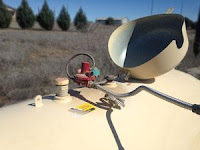 |
Tank mounted regulator
|
Regulators are available in different sizes and are rated by the BTU output. The BTU rating is normally listed on the regulator body. Most homes will require a regulator of 400,000 BTU or more. When the BTU rating of each appliance is added together, this will be the minimum BTU required for the system. A gas heater can use as much as 150,000 BTU whereas the EZ Freeze Gas Refrigerator will only use 1750 when on high flame. If the BTU demand is too high for the regulator, it will freeze up and the refrigerator will shut off. After the ice inside of the regulator defrosts, the fridge will have to be relit. This scenario is usually present when a small regulator is used to supply heaters, a water heater, and range all at one time. The small regulators are typically used to supply only one appliance or a multiple of low BTU appliances at one time.
The automatic change over regulator is designed to connect to 2 tanks at one time and automatically switch to the second tank when the first tank goes empty. At this point, a red flag indicates that the first tank is empty. The user can then remove this tank and get it filled without interrupting service to the appliances.
Plumbing
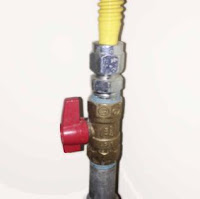 |
| Flex line & valve |
A typical house is plumbed with rigid pipe throughout. Each appliance should have a valve located at the stub out location and connected from the valve to the gas hook up with a flex line. Most gas refrigerators require a 3/8 inch gas flex line with a 3/8 female flare fitting at the end. We recommend a 4 foot long coated gas flex line. The flare fitting does not require sealant since the flare is self sealing.
The smaller portable tanks and regulators can use flexible rubber hoses for connections. This is recommended for outdoor use only on a temporary basis.
Beware of cheap non adjustable regulators. The supply pressure of a gas refrigerator is critical and the wrong pressure can cause poor performance or a shortened lifespan. Use only a high quality adjustable type regulator.
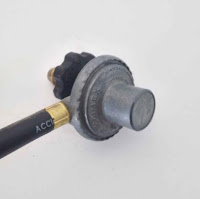 |
Non-adjustable regulator
|
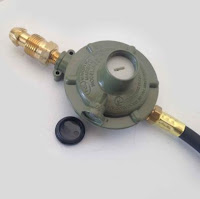 |
Adjustable regulator
|
Always check your connections with a soapy water solution prior to operation. Check local building codes for restrictions. Consult a professional for installation.
We are the leader in propane to natural gas
appliances. Contact Warehouse Appliance for more information more off-grid living information. Contact Warehouse
Appliance at either 928-636-1955 or by visiting our website at
http://www.warehouseappliance.com.
 Many dream of living off grid. No more connection to the big power companies. Control your energy use as you see fit. No more unexpected power outages. Being self sufficient and green. Warehouse Appliance discusses why folks are switching to propane appliances.
Many dream of living off grid. No more connection to the big power companies. Control your energy use as you see fit. No more unexpected power outages. Being self sufficient and green. Warehouse Appliance discusses why folks are switching to propane appliances.




